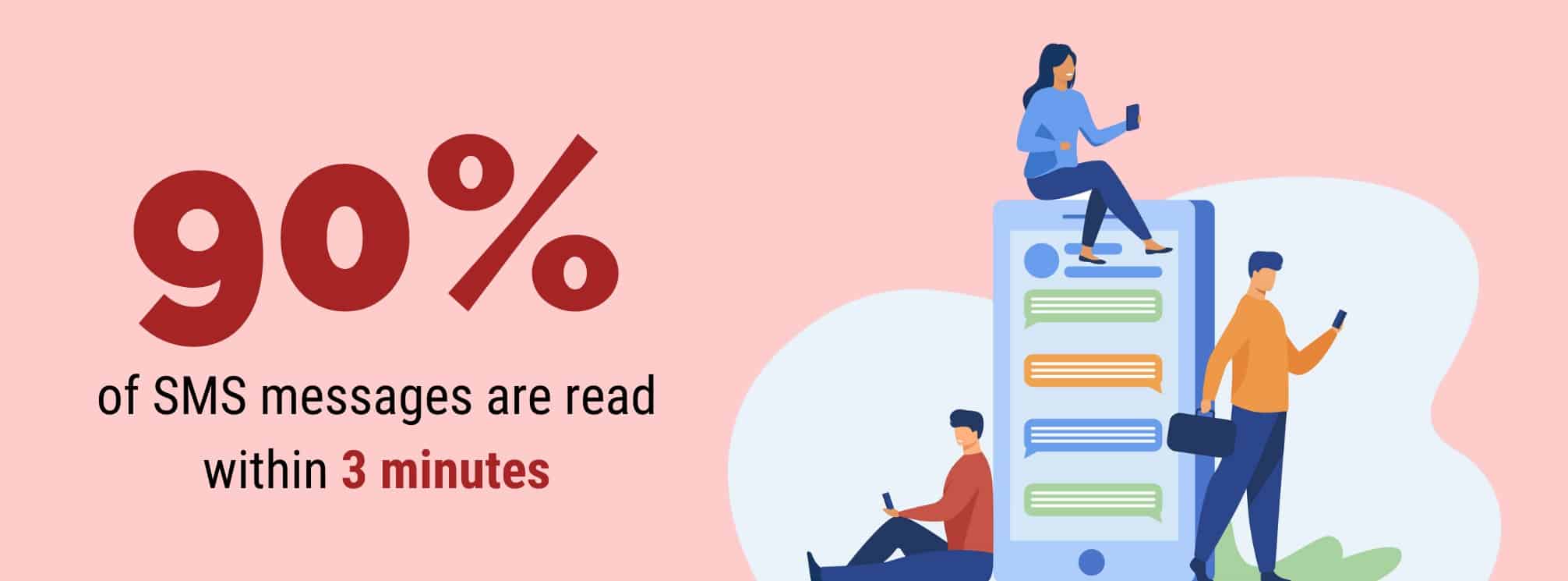Last updated on March 7, 2024 at 10:54 am
Using texting for business communication can be an effective and efficient way to stay connected and keep employees engaged. In our daily lives, SMS has become a dominant form of communication. And industry trends have shown that employees are looking for that connection at work too. In this blog, I’ll share everything you need to know about using SMS text for employee communication.
Why Is Texting Good For Business Communication?
First of all, it’s worth investing in texting because that’s how employees want to receive company communication. In our recent survey of 1,000 frontline employees, we found that 50% of employees are interested in getting text messages from their employer.
SMS messages also gain a high open rate and are typically opened within minutes of being received. In fact, 90% of SMS messages are read within 3 minutes of being received.
Increased open rates and speed to opening means texting is a great channel for time-sensitive and important employee comms.

SMS vs MMS: Is There a Difference?
In the world of texting, there are two mobile messaging technologies: SMS and MMS.
SMS texting stands for short message service. And MMS stands for multimedia messaging service. So, what’s the difference?
What is SMS?
- SMS is a text-only messaging technology where you send and receive short, text-only messages up to 160 characters.
- SMS messages are limited to text and basic characters and do not include any multimedia content, such as images, audio, or video clips.
What is MMS?
- MMS allows users to send and receive multimedia content, including images, audio, and video, in addition to the plain text portion of the message.
- MMS messages can be up to 1,600 characters in length and can include content of up to 1MB in size.
- MMS messages require a data connection to send and receive, which differs from SMS messages which can be sent and received over a cellular network without a data connection.
While MMS allows for the use of multimedia content, it can be more expensive and less reliable than SMS due to increased data usage and the potential for compatibility issues with different devices, device OS, and carrier networks.
How Can You Use Texting for Business Communication?
You can use SMS to effectively connect with your employees and keep them engaged and informed. This is especially true for your frontline workers, who lack access to email or an intranet during working hours.
As you think about SMS becoming part of your larger comms plan, you’ll want to consider:
- Obtain consent. Before sending any SMS to employees, you need to make sure they have given their consent to receive messages from you. Do this by asking employees to opt in via a sign-up message. Compliance in this area is a big deal, and employees are protected under TCPA, the same as consumers.
- Keep messages short and to the point. SMS is a concise form of communication, so keep your messages brief and focused. Make sure to include all the necessary details, such as the date, time, and location of any events or meetings.
- Target your messages. If you have many employees, you should think about ways to target the SMS message. Using geolocation, shift schedule, or facility to avoid over-messaging to other employee groups.
- Monitor your results. Keep track of your SMS deployments to see how messages are received. You can use metrics such as open rates and click-through rates to determine how engaged your employees are with your messages. Use this data to refine your messaging strategy and improve your results over time.
- Consider Privacy. SMS may not be the best choice if you need to communicate sensitive or confidential information. There is a risk that messages could be intercepted or read by unintended recipients who might see the message on that person’s device.
Weaving SMS Into Your Communications Channels
SMS can be valuable to use for internal communication, especially in situations where the timeliness of the message really matters. However, it is important to keep in mind that SMS may not be the most appropriate communication channel for all types of messages. You should consider the content, audience, and context when deciding which channel to use.
In general, SMS can be a convenient and efficient means of communication for employees who are often on the go and may not have access to an intranet, email, or mobile communications app.
Here are some ways SMS may be a useful tool for connecting with your workforce:
Urgent notifications.
Nothing is more critical to your workforce than being able to provide timely communication regarding emergencies and unexpected facility closures. Providing that information in a timely manner can save time, and allow those impacted to react with enough notice.
Shift schedule changes.
SMS messages can be a quick and easy way to notify certain employees of any changes to their shift schedule or work locations for the day.
Immediate feedback.
SMS messages can be a great way to quickly gather employee feedback . Directing employees to content or a survey link via SMS can help increase survey completions and provide you with valuable insights.
Training and development.
Use alerts to notify employees about new or updated training and development opportunities. For frontline employees, it is critical that they stay in compliance with your company’s required training and certifications.
Benefits and HR information.
Communicate important HR information to employees, such as open enrollment deadlines or updates to company policies. Short messages with a countdown or pointed language can make sure you are getting high participation for those critical programs.
Ready to Reach Your Frontline Workers With SMS?
We’re seeing the employee communications landscape continue to evolve as more channels and technologies emerge, all while the challenge to engage employees persists. We encourage communicators to look at their channels, message frequency, and KPIs to create a comms ecosystem for your needs.
Request a demo today to find out how we can help you connect and engage your frontline teams.
About the Author
Michael Marino is the Vice President of Marketing where he oversees the creation and execution of theEMPLOYEEapp’s marketing programs. Before joining the team, Mike held marketing leadership positions in both the B2B and DTC spaces in channels that include media, manufacturing, and professional services. Mike is passionate about demand gen, mar-tech, and being able to create campaigns that connect with Internal Comms audiences.
Subscribe To The theEMPLOYEEapp Newsletter
Comments are closed.




